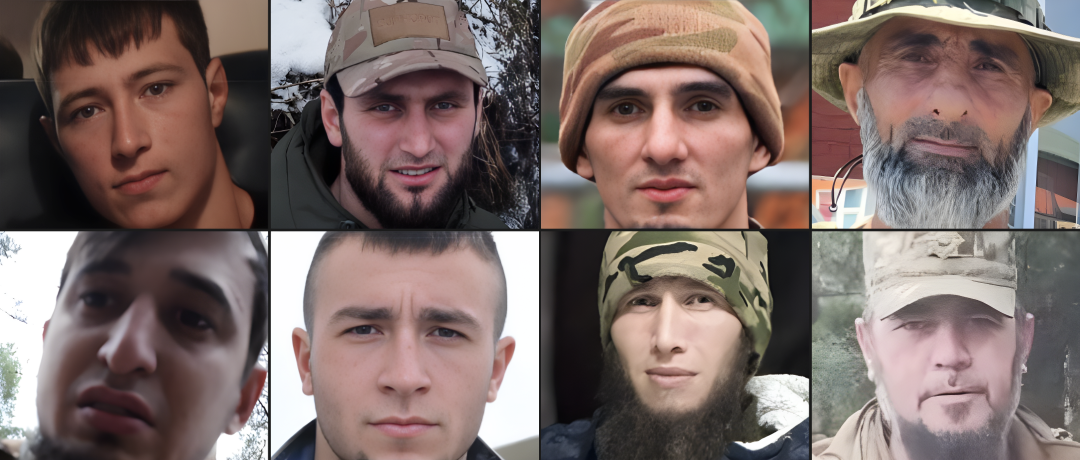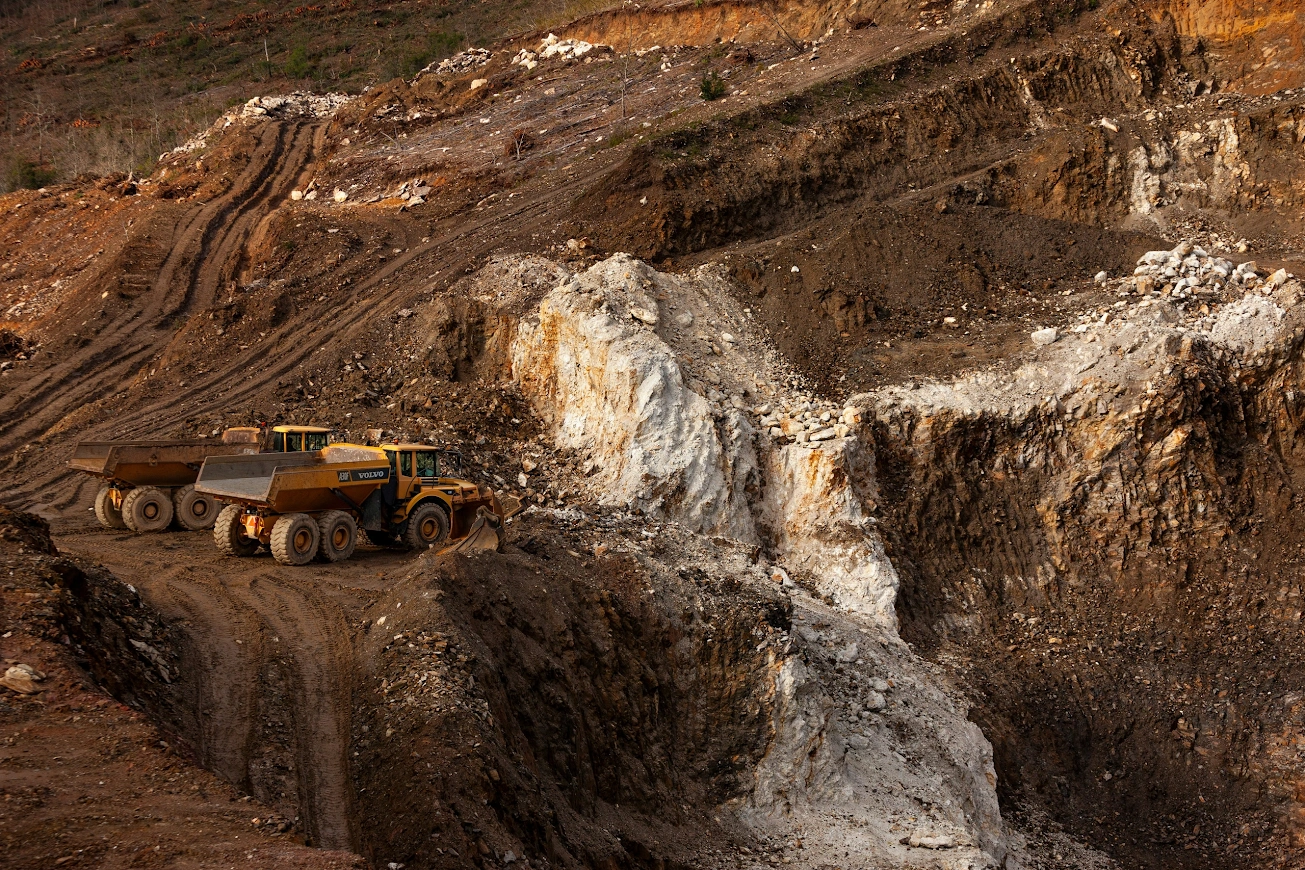Imagine buildings that are completely destroyed from the inside: shattered ceilings, cracks in the main walls, no utilities or even sewage. There are hundreds of such buildings. They are uninhabitable: water, electricity, gas, heat – none of this is available, just ruined concrete blocks.
However, the Russians found a way to quickly cover up their own war crimes: to create a picture of "rebuilding the city," the occupation authorities replace windows in buildings that have been destroyed from the inside.
From the Russian invaders' point of view, the situation is surprisingly successful: citizens are deported or faced with impossible conditions for obtaining new housing or compensation, and the surviving housing is taken away and given to the Russian military and their families. At the same time, the federal budget of the Russian Federation allocates money for the "restoration of Mariupol", which is stolen by the occupation authorities at all levels.
The result of such actions: a good TV picture for the Russians, active genocide of the Ukrainian population and... a human shield of citizens. Because in fact, the Russians are indeed building temporary concrete structures (housing without utilities) in Mariupol. But all of them are located on the periphery of the city, along the lines of a potential counteroffensive by the Ukrainian Armed Forces.
Read more about the tenders for icons, lies about the restoration of the city, the genocide of the surviving citizens, uncleared rubble with human bodies underneath, and the PR activity of the fascist Russian Federation based on murder and war crimes in the Molfar OSINT investigation.
Molfar in social networks 👉 Molfar Global
The real state of destruction in captured Mariupol
To estimate the destruction of the Mariupol city during the siege by Russian troops, we will refer to Ukrainian resources. This is because the Russian side has never publicly reported its own estimates of the city's destruction.
Damage estimates from the city administration of Mariupol
This assessment is based on the reports of residents who documented the destruction of their homes and made an online request to the resources of the Mariupol City Administration to apply for compensation from the city budget.
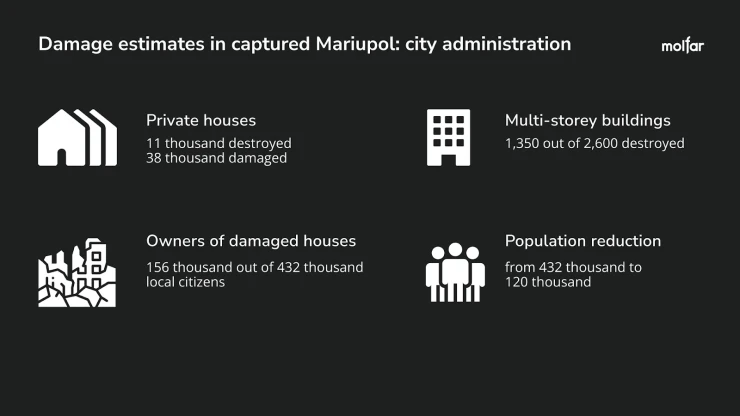
In December 2022, the Mariupol City Administration said that 11,000 private houses were destroyed and 38,000 houses were damaged during the siege of the city. In March 2023, the Mariupol City Administration estimated that 1,350 apartment buildings out of a total of 2,600 were destroyed during the seizure of the city. At the same time, as of October 2022, 156 thousand residents' homes were damaged.
Since the beginning of the full-scale invasion and as of December 2022, the city's population has dropped from 432,000 to about 120,000 residents.
Damage estimates based on an interactive online map
This map was created by social media specialist Vitaliy Stutman. It is a simple custom Google map that shows destroyed and damaged buildings in Mariupol. Each marker is attached with photos or videos of the destruction or damage.
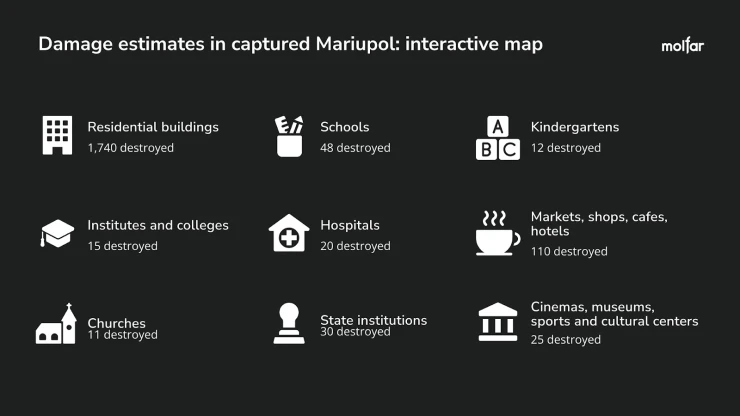
According to the published interactive map, the destruction of houses (1740), schools (48), kindergartens (12), institutes and colleges (15), hospitals (20), markets, shops, cafés and hotels (110), churches (11), cinemas, museums, sports and culture centers (25), and government agencies (30) was documented.
The city reconstruction progress according to the occupation authorities of Mariupol
Thus, the Russian side does not report the actual amount of damage. Instead, it reports on the constructed and restored facilities outside the context of their number in the overall damage estimates. We propose to compare the scale of destruction with the scale of the city's "reconstruction".
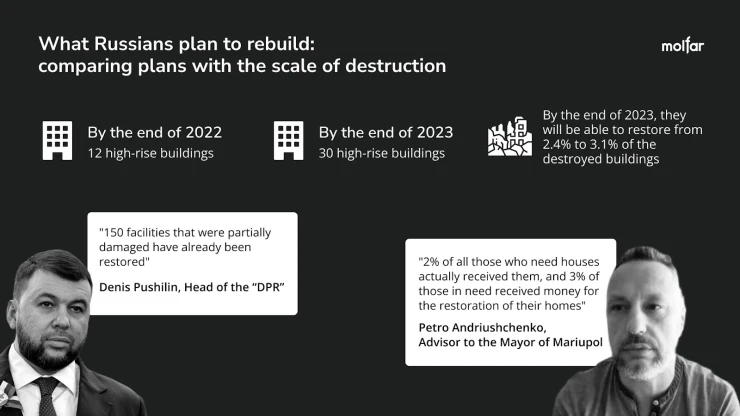
In the summer of 2022, Russian media reported that by the end of the year, Russia plans to build 12 five-story buildings for 2023. According to Andriushchenko, the construction is designed for only 2% of all city residents in need of housing. In November 2022, Russian media reported that only 15 families had moved into the new complex.
In March 2023, the mayor of Mariupol, Vadym Boychenko, said that it would take about 20 years to fully restore the city. As of March 2023, the occupation authorities planned to build 30 apartment buildings by the end of the year, which is 2.2% of the destroyed ones.
In November 2022, Pushilin reported that 150 buildings had been restored and that work was underway to restore another 1,250. These are probably the least damaged buildings.
According to the Russians, as of January 2023, 1 billion rubles (~$12.7m) was allocated to the city's residents, with ~4 thousand people receiving the money, which is roughly 3% of the population. They also received 3 types of compensation:
- $446/m2 or a new apartment in case of house loss;
- $76/m2 if the house is not destroyed but needs to be repaired;
- and $1300 for each family member in case of house loss.
Below is a comparison of the compensation offered to Mariupol citizens by the occupation authorities with the real housing prices in Russia and Ukraine.

Let us emphasize once again: despite the underestimated compensation payments, the Russian occupation authorities have managed to meet the needs of only 3% of all needy Mariupol citizens. Therefore, the real situation with payments is ten times worse than the nominal one.
Russians are not rebuilding but building up Mariupol: what is the fundamental difference?
Analyzing the addresses where Russians have built new homes, we can see that they were built on a wasteland. That is, there was nothing there from the very beginning; the city is not being restored, but rather built on empty land plots. The photos of the probable house locations are from March 2022.
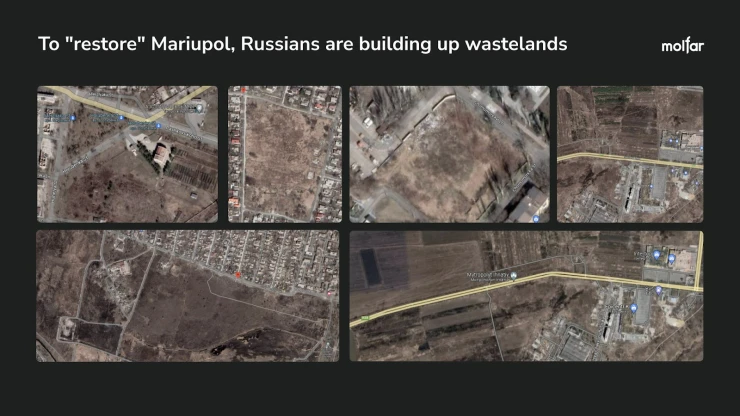
This shows the following: the priority for the Russian occupiers is not to restore the city, but to simply build up unoccupied areas with conditionally habitable concrete structures. Talking about "compensation and restoration" is just talk, in practice, they are not going to rebuild what has been destroyed.
In June 2022, the Russians began spreading lists of houses to be demolished or repaired. The Mariupol mayor's office reported that this was a manipulation, as they were trying to "lure" Mariupol residents back to the city. According to the map, which was created based on the published addresses for demolition, at least 30% of the houses are not damaged, and there are also surviving houses marked "demolish".
According to the city administration and Ukrainian media, the Russians resorted to such manipulation to get Mariupol residents to come to the city for saving their surviving property or to return to live because their homes would supposedly be repaired. There are several theories to explain this:
- ideological, the Russians wanted to create a picture of a "prosperous liberated Mariupol" as soon as possible;
- to cover up their own crimes, there may still be bodies of people who died in the first months of the full-scale invasion under the rubble of buildings. It takes too long to manually dismantle the rubble with manpower, so the occupiers simply demolish the building and send the construction waste to the landfill along with the remains of the Mariupol residents’ bodies;
- collecting population data.
The theory of covering up war crimes is confirmed by the case of the Mariupol Drama Theater, which was destroyed by a Russian air bomb with hundreds of civilians inside. After that, the ruins of the theater, along with the bodies of the people underneath, were demolished by the Russians using heavy construction equipment.
Russian plans to "rebuild" the city and propaganda stories
In September 2022, Russian Deputy Prime Minister Marat Khusnullin said that there is an approved plan according to which the city is planned to be restored in 3 years. At the same time, according to the Minister of Construction and Housing and Communal Services of the Russian Federation, Irek Fayzullin, it is a "complete restoration". Later, it was announced that the three-year plan could be completed in 2 years.
Instead, in March 2023, the mayor of Mariupol, Vadym Boychenko, made a different, more realistic statement. According to him, it will take about 20 years to fully restore the city. Given the rate of "recovery" – 3% per year – the occupiers will definitely not be able to restore the city in 3 years!
Master plan for the restoration of Mariupol
In October 2022, a detailed development plan for Mariupol until 2035 was published, developed in Moscow and prepared by the Unified Institute of Spatial Planning at the request of the Russian Ministry of Construction. The plan lists 4 types of buildings in Mariupol: historical, apartment and private houses, post-war and late Soviet buildings. There is also information on the projected population of Mariupol for 2022 – 212 thousand, for 2025 – 350 thousand, 2030 – 450 thousand, and 2035 – 500 thousand residents.
In the Russian media The Village.ru, an anonymous construction expert says the following about the occupiers' plans.
- It does not indicate how the population is planned to more than double in 10 years, who these people will be, what their gender and age composition will be, etc.
- It is also paradoxical that the restoration starts with the historic center and Azovstal. The most densely and severely affected neighborhoods, where tens of thousands have lost their homes, are scheduled for restoration in 2030-2035.
Apparently, the real objective of the document is not long-term strategic development, but a very specific tactical story: to quickly hide the traces of war in the center, to create a cheerful picture on a small piece of urban space. Not for the sake of the city's residents, but for the sake of the viewers who will see this picture.

The Russians are probably hiring young people to record propaganda videos about how they are rebuilding Mariupol. For example, blogger "Masha from Mariupol" Chushykina Maria Danilovna, and her alleged husband "Mariupol Vanek", Chushykin Ivan Aleksandrovich, started filming videos about the "restoration" of Mariupol 2 months ago. Their channels feature videos with Russian symbols and photos of Putin.
In March 2023, Chushykina registered as a Russian individual entrepreneur in Mariupol, probably to receive payments for filming propaganda videos. In 2021, Chushykina was registered in Mariupol at 44 Zemskaya Street, apartment 4. Ivan has been registered in Mariupol since 2014 at 16 Pokryshkina Street, apartment 14.
Most likely, they were promised housing for their activities, as both of their houses are on the list for demolition. Also, the channel "Strength in Truth 🇷🇺 Mariupol" was found, the channel description has the same financial information as "Masha from Mariupol" channel.
In the video above, the propagandist films high-rise buildings with painted facade walls. This is all that was done in terms of significant changes. The condition of the buildings from the inside was not recorded on the video. Instead, it was recorded by residents of the buildings on the channel of the Mariupol City Administration.
In the video above, you can see one of these "externally restored houses" – new windows in a heavily damaged building, with only raw concrete inside, no utilities or other living conditions.
Who is "rebuilding" Mariupol?
According to Andriushchenko's interview of March 2023, the Russians do not allow Mariupol residents to participate in construction because they fear that they will surrender their positions to the Ukrainian Armed Forces. The Russians are following a "policy of replacement": they do not hire Mariupol residents and do not pay their salaries. According to him, they are being pushed to "self-deport" and are being replaced by Russian civilians who are being settled in the surviving houses that have no owners and are recognized as "ownerless."
According to Mariupol residents, people from the Far East of Russia and the Caucasus are being brought to the city. As of March 2023, about 1,000 apartments have already been recognized as ownerless and are being distributed between newly arrived Russians.
Money and the occupation authorities' corruption
The Russian authorities do not publish detailed estimates for construction in the occupied territories, and the calculation is also complicated by different sources of funding – both the federal budget and local budgets of the Russian Federation’s subjects. Expenditures for the needs of the occupied Ukrainian territories are likely to be included in the so-called "special infrastructure project," which totals 377 billion rubles ($4.77 billion) for 2023-2025 and is distributed as follows.

At the same time, these amounts may include other expenses besides construction. Mariupol accounts for one-third of the construction activity in all occupied territories (excluding Crimea), so the proportionally planned three-year expenditures for the city could amount to $1.57 billion. At the same time, according to Mayor Vadym Boychenko, the cost of rebuilding Mariupol alone is estimated at $14 billion for 7-10 years.
In fact, the reconstruction of Mariupol requires three times more money than the occupation authorities have declared and five times more time. But in the face of total corruption, most of the funds will not even reach the people of Mariupol.
According to a journalistic investigation, most needy residents of Mariupol continue to live in basements and garages, as the keys to new homes are handed out only "on camera": only the military or those who work closely with the authorities of the so-called "DPR" and actively support Russia receive housing. In July 2022, a report was released stating that the houses are being built by the Russian Ministry of Defense, so the apartments will be given primarily to the military, as well as to residents who cooperate with the Russians and work in structures important to Russia: the seaport, railway junctions and utilities.
Tenders for the supply of icons, not building materials
Molfar investigators found a tender dated May 23, 2023, for "Performing work on the reproduction of icons for the exhibition Cures of the Russian Icon and organizing the exhibition Cures of the Russian Icon" – 60 million rubles ($75 thousand) are planned to be spent on this event in the destroyed impoverished city.
This is just one example of government corruption and embezzlement of the city's budget, but it is very telling.
The quality of houses being built up in the destroyed city
The Russian media reported on the construction of temporary one-story concrete hostel-type modules with rooms for 8 people, but they are being placed in territory that is not suitable for living. For example, on Flotska Street, where there is an old landfill that is smoldering. In July 2022, the landfill was on fire for several days, and according to Andriushchenko, a large amount of chemical poison was released into the air.
In 2022, the advisor to the mayor of Mariupol, Petro Andriushchenko, reported that Russians were building "prefabricated concrete chicken sheds" under the guise of high-rise buildings. Concrete boxes are stacked on top of each other on concrete bricks without being fastened together. Also, according to Andriushchenko, such structures will not be heated.
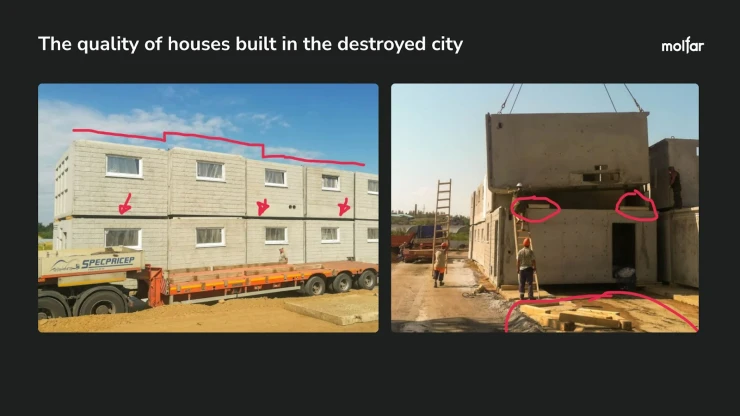

There is no "hint of a toilet/shower" in the buildings, and the windows are at floor level. The construction is uninsulated, with air, wooden beams, and foam between the floors of the prefabricated structure. Such houses are not suitable for living, they can only serve as temporary shelter in the warm season.
Using buildings as human shields
In July 2022, it was reported that Russians were building a human shield in Mariupol. Andriushchenko said that "modular houses" for homeless Mariupol residents are being built a few hundred meters from the defense line.
In an interview as of March 2023, Andriushchenko said that the construction was aimed at fortifying the city and preparing for a counteroffensive. The Russians are massively building defensive structures, followed by new residential neighborhoods, which they plan to use as human shields. He also confirmed that all the new buildings are located on the line of a potential counteroffensive of the Armed Forces of Ukraine during the expected deoccupation of the city.
Lies about restoring communications
Russian media report that communications, water, gas and electricity have been restored. According to Mykola Osychenko, president of Mariupol TV, there will be no centralized heating in Mariupol, as the boiler houses were powered by gas, and the gas system in Mariupol is built on the principle of "blockchain," meaning that all gas distribution stations and the entire pipeline must be intact for gas to reach consumers. However, in Mariupol, the pipeline is broken.
In July 2022, there was no water in the city. In August 2022, according to Ukrainian media, there was no electricity and water in the city.
As of December 2022, Boychenko reported that there was no heating season in Mariupol, and residents were freezing. To improve the situation, the Russians distributed heaters, and people stood in kilometer-long lines to get them, but most houses did not have electricity to connect them. It was also reported that when they tried to supply electricity to houses, fires often broke out. As of February 2023, most houses did not have centralized heating and had problems with other utilities. Due to the lack of heat, a flu epidemic was spreading across the city, with the death rate reaching 250 people per week in December 2022. People wrote on buildings and asphalt, "SOS! We are freezing!" (SOS! Замерзаем!).
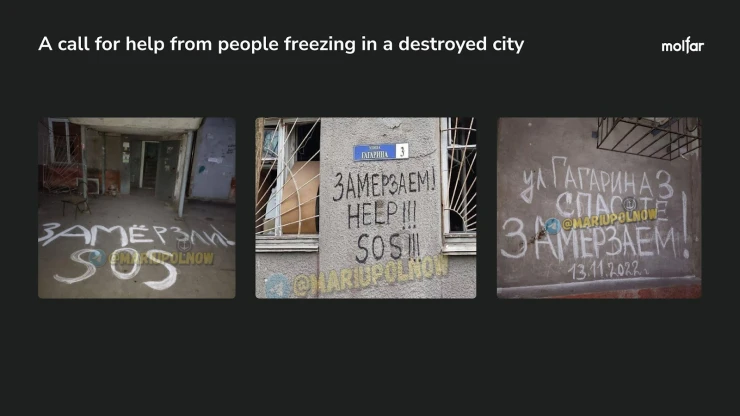
Conclusions: Russians continue to destroy Mariupol
The Russian occupation authorities are committing genocide in the captured city, stealing budget funds allocated for the restoration and turning the city into a fortified defense line, where they plan to use the people of Mariupol as human shields. Civilians have to go through filtration camps, after which the Russians will decide whether they are allowed to stay in the city or go to a colony or a Russian prison. Even if a person is allowed to stay in the city, he or she will not find a job because the occupiers refuse to employ locals. In this way, the occupiers force people to "self-deport" in order to bring in Russian citizens from remote eastern regions to replace them.
The only thing the Russian invaders succeeded in was creating propaganda stories that show exterior repairs in completely destroyed buildings.
Unfortunately, in this investigation, we did not tell even half of the real state of affairs in the temporarily (!) occupied Mariupol. More information on the Molfar investigation can be found 👉 at this link.
Additionally: on the importance of Mariupol and its role in Russia's war against Ukraine
Mariupol is a port city with access to the Sea of Azov. Even a completely destroyed city does not prevent Russians from loading ships in Mariupol ports and sending goods for sale through the Kerch Strait, then across the Black Sea, and then as far as the eye can see. Berdiansk is the same way. Berdiansk is the city located 70 kilometers southwest along the Azov Sea coast from Mariupol, which the Russians took without a fight. These are very important logistics hubs for merchant shipping. These two cities are of great value because of their ports, and they are also a transit corridor from the Russian Federation to the Crimean Peninsula through mainland Ukraine.
Before the Russian invasion, a strategic amount of metal was produced in Mariupol at the Azovstal plant. This plant was one of the largest metal producers in the world. The smelted metal was actively used for military purposes, and the products were transported by sea: the finished products were immediately loaded onto barges and sold abroad. Now this is no longer the case, the plant is destroyed.
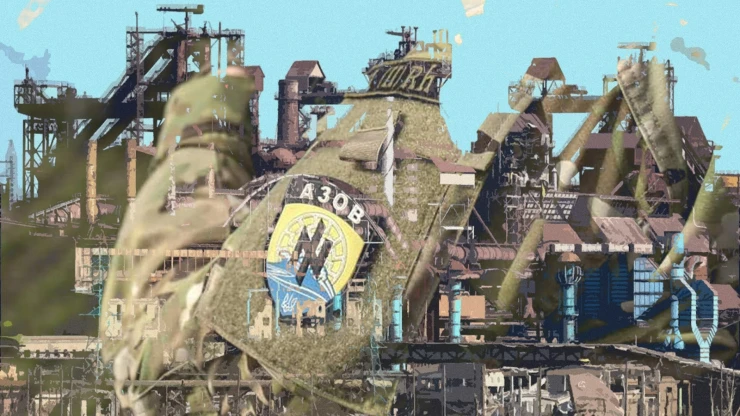
Regarding the importance of Mariupol in the war and the heroic actions of its defenders, let us recall the main point. In a complete encirclement, with a preliminary ban on the creation of defense lines, the leader of the Azov movement, Lieutenant Colonel Denis Prokopenko, organized the defense of the city. He took command not only of the Azov units, but also of all the surviving units that wanted to hold the line without any real chance of victory. The defense lasted 86 days, 82 of which were spent in complete encirclement. Thanks to the heroic actions of Ukrainian defenders: Azov, National Guard, Marines and all related units, thanks to the defenders of Mariupol and Azovstal, Ukraine survived the first months of the war.
If it were not for the operation to defend Mariupol, experts estimate that Russian troops would have continued their invasion without resistance. The manpower, time, and weapons they spent on Mariupol could have been enough to capture Zaporizhzhia, Dnipro, and the siege of Odesa. The defenders of Mariupol gave Ukraine and Ukraine's partners vital time to form defense lines and transfer weapons to resist the invaders.
✉️ To contact the team and receive a comment, please fill out the form below or send your request to: [email protected]



